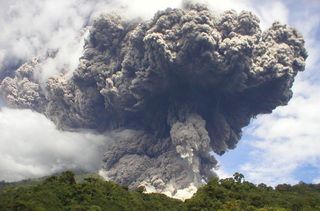New Type of Volcanic Hazard Discovered

Scientists have uncovered a new type of worrisome volcanic eruption after studying images of an odd-shaped ash plume that came unexpectedly crashing down.
Typically, the gentlest part of a volcanic eruption is the gradual falling of ash. But the plummeting plume of an eruption in South America four years ago appeared to cause damage to oil pipelines on the ground that experts would not have expected.
"The usual volcanic plume consists of a stalk capped with an umbrella, and resembles the mushroom of an atom bomb blast," said Susan Kieffer a geology professor at the University of Illinois at Urbana-Champaign. "But the umbrella on this plume was wavy, like the shell of a scallop."
What happened
When the Reventador volcano erupted in 2002 near Quito, Ecuador, the flood of ash from the explosion traveled down to valleys several miles away. Moving close to the ground, the outflow heated the air, which rose, carrying the ash up with it.
"A volcanic plume rises until the atmosphere becomes so thin that the mixture of air and ash loses buoyancy and starts to spread laterally, forming an umbrella," said Gustavo Gioia, a theoretical and applied mechanics professor at the University of Illinois at Urbana-Champaign. "The umbrella spreads and cools for a long time before the ash begins to fall gradually."
But the ash wasn't as hot as normal in this case, and the plume was loaded with steam, too.
Sign up for the Live Science daily newsletter now
Get the world’s most fascinating discoveries delivered straight to your inbox.
The mixture was more turbulent than normal, and the umbrella couldn't spread very far and started plummeting with a huge amount of energy.
New type of risk
"The initial ash fall died in the formation of the plume, but only to come back with much more punch than before," Kieffer told LiveScience. "Our analysis suggests that the Reventador umbrella collapsed rapidly, forming new and especially dangerous ash flows."
Such quick collapse of ash, much different from the gradual fallouts of typical eruption umbrellas, may become unusually forceful, the scientists now say.
According to another report, which Kieffer and colleagues cite, the fallout destroyed an empty oil pipeline and carried away small bridges. Another 3-foot diameter pipeline filled with crude oil was knocked downhill about the distance of a football field.
The flows might also have contributed to a volcanic cloud that descended near the Quito airport and caused the early phases of a shutdown that lasted more than a week, said Pinaki Chakraborty, the study's lead author.
The research is detailed in the March 15 issue of Geophysical Research Letters.

